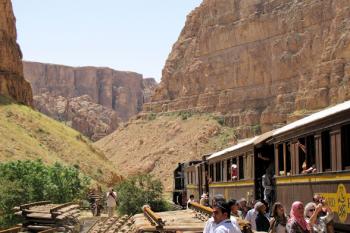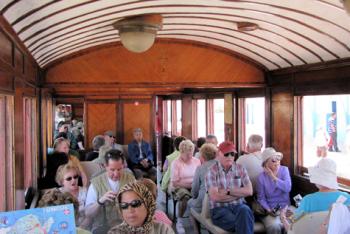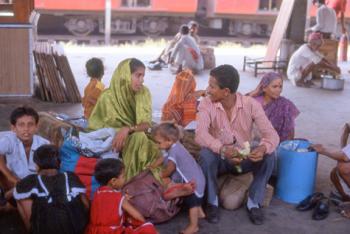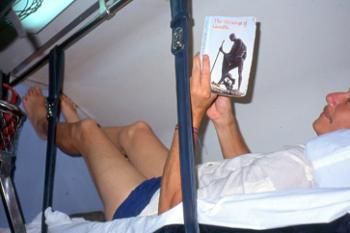Narrow-gauge and offbeat railways
Addressing ITN subscribers, we previously printed this information request from Jack and Elizabeth Kaufman of Lake Quivira, Kansas: “We would be interested in travelers’ suggestions for scenic or unusual railroad trips.
“Traveling by rail on narrow-gauge tracks or offbeat routes can provide fascinating insights into rural communities, not to mention incredible vistas. Some tourist spots can only be reached in this way. Whether it’s a route used primarily by locals for daily transportation or something that all visitors do, we would like to hear about any offbeat train trip that offers a special experience of some type.”
We asked you to write about any recent offbeat rail experience outside of the US, describing the train and telling us where your trip took place and what was memorable about it. We also asked you to tell us approximately when (month/year) the trip took place and to provide any contact info or instructions on finding the location.
Responses were printed in the previous two issues, with the remainder presented below.
My parents, brother and I traveled to Germany and Austria on a river cruise with Grand Circle Cruise Line in late November 2006. On our free day in Linz, AUSTRIA, the morning dawned cold and snowy, but we managed a short walking tour and a museum visit. The snow stopped by late morning, and after lunch we ventured out again and discovered the Pöstlingbergbahn tram.
We boarded the tram at the Hauptplatz (Main Square) and took the 20-minute ride up the hill to Pöstlingberg. The tram made frequent stops for visitors and residents, including a stop for the Linz Zoo. It passed through a lovely residential area of alpine-style houses, many with outdoor swimming pools that were closed for the season.
The top of the hill was quiet and peaceful, especially due to the lack of visitors on this snowy day. We admired the frosty scenery and visited the pilgrimage basilica dedicated to the Seven Sorrows of the Virgin Mary, then we started our return trip.
The round-trip fare was less than €5*, and the tram ran frequently.
Pöstlingbergbahn is one of the steepest adhesion railways in Europe. I didn’t know this at the time I rode it.
I am not a train expert, but I can certainly recommend this relaxing excursion.
Diane Harrison, Chesterfield, MO
* As of press time, a round trip cost €6.20 (near $6.60).
During our visit to TUNISIA in May 2009, my wife and I stopped in Métlaoui for an hour-and-a-half round-trip ride on the Lézard Rouge (Red Lizard) train through the scenic Seldja Gorge. The cost was 20 Tunisian dinars (near $14) per person.
The train was built in France a century ago and was originally used by the bey (leader) of Tunis.
This restored (but not air-conditioned), 6-carriage train is certainly not luxurious, but it does exhibit some of its former splendor.
While the train, itself, was interesting, the scenery, especially the Seldja Gorge, was the main attraction.
Stephen Addison, Charlotte, NC
I remember a wonderful train trip I took about 25 years ago from Johannesburg to Cape Town, SOUTH AFRICA, during springtime. It was on the Blue Train.
The trip involved one night aboard in a stateroom and included various meals. Some of the staterooms were quite grand.
The journey actually had begun in Pretoria, but we boarded at its first stop. I was with a group of golfers who had played in the north, and we were on our way to more outdoor activities at the end of the line.
Over the hours, the train passed through beautiful country. We made one stop in Kimberley but had little time to do much but gawk. The morning after our departure, we found ourselves in wine country.
Eventually, we went around the mountains bordering the south end of Africa. This took us to our terminus in always-worthwhile Cape Town.
Philip H. De Turk, Pinehurst, NC
In October of 2009, I traveled on the “Southern Cross” rail journey with Shongololo Express (www.shongololo.com/tours/southern-cross-northbound). After being transported from nearby Johannesburg, SOUTH AFRICA, our trip began at the Rovos Rail Station in Pretoria, and we wound our way through MOZAMBIQUE, SWAZILAND, BOTSWANA, ZAMBIA and ZIMBABWE, with our final stop being Victoria Falls.
The 16-day journey provided a wonderful introduction to the African continent, including the food, wildlife, culture and natural landscapes. It was a unique experience, and I have not seen another to match the scale.
Passengers (mostly American, German and Australian) were accommodated in four categories of cabins, some of which had private bathrooms.
Many tours were included in the base price (including a quick Chobe River cruise that took us from Botswana into Namibia via the Caprivi Strip), and more were offered for additional fees. The train carried the vans that were used for transportation at each stop.
I am so pleased that I was able to take the journey when I did, as the route offered today is slightly shorter (12 days) and no longer includes visits to Botswana, Namibia or Zambia. However, a trip taken today would be at a rate of exchange (US dollars to South African rands) much more favorable to Americans.
Femi Faminu, Los Angeles, CA
Willie Nelson, a contemporary philosopher of some note, once wrote, “Most people have a fantasy of catching the train that whistles in the night”… and he’s right.
A train passes through time as well as space. From the window of a train, the world is a visual banquet, one you taste as it flows past. People catch your eye and smile, imagining themselves sharing your journey.
Sadly, passenger trains have almost become obsolete in America. Fortunately for travelers, trains remain part of daily life in the rest of the world, aesthetically worn but still mechanically valiant.
Of the countless amazing offbeat train trips on our planet, there are eight I’d like to mention.
I checked to ensure that all are still operating. I left others out because service or equipment has deteriorated (e.g., south from Lima to Arequipa, Peru), I couldn’t find reliable current info (e.g., Santiago to Puerto Montt — a fabulous trip) or service has stopped (e.g., Arequipa to Puno).
Here are the trips, in ascending order, with the most interesting at number 1.
8. From Antananarivo, capital of MADAGASCAR, you can catch a train to the tranquil Périnet Special Reserve to watch families of chattering ring-tailed lemurs play in the forest. Later, ride the train that descends steeply from Fianarantsoa, in the highlands, through 48 tunnels and across 67 bridges to Manakara on the coast. I took these routes in 2010.
Madagascar is a land of unique wildlife, rainforests, lush highlands, endless beaches and traditional cultures.
7. In MOROCCO, a fine route loops from Tangier to Casablanca, then on to Marrakesh and back to Tangier. Marrakesh, a renowned travelers’ heaven in the 1960s and ’70s, is still fascinating.
On this trip — because of cultural diversity, attire, world views and more — your traveling companions may be almost as much an attraction as the destination. (I did this route in 1991 but am returning in 2017.)
6. In PERU, many travelers ride the train from Cusco to Machu Picchu, but they miss out on the route from Lima to Huancayo, a town high in the Andes. A wonder of the railway world, the tracks tunnel through the hearts of frozen mountains and cross 58 viaducts spanning black-walled gorges.
At times, tracks are chiseled into cliffs so close to vertical that even the most intrepid passengers avert their eyes from the edge.
Reaching 15,686 feet, it’s one of the highest passenger train routes in the world. With that in mind, there was a nurse on board to dispense oxygen, if requested. I rode this train in 2007.
5. British-built coaches in fairly tired condition chug out of Bulawayo, ZIMBABWE, for an intriguing overnight trip to Victoria Falls, one I took in 2012. A first-class sleeper for two currently costs about $12 plus $4 for bedding. You’ll spot elephants, baboons, impalas and giraffes along the way.
As darkness closes in, the train enters Hwange National Park, renowned for its black leopards. (Imagine yellow eyes watching as you pass.) In the morning, hop off the train almost on the front lawn of historic Victoria Falls Hotel and be energized by the thunder and mist from the mammoth cataracts.
4. Don’t miss the trip from Chihuahua City, MEXICO, to Los Mochis on the west coast. Because the tracks of the Chihuahua al Pacifico go through the magnificent Copper Canyon, this may be the most spectacular train ride in North America.
You’re free to get off at Cuauhtémoc, to visit a community of German-speaking Mennonite ranchers, and at Divisadero, where you can hike down into the canyon. Along the way, meet Tarahumara Indians, renowned for their endurance as long-distance runners. I took this train in 2014.
3. On Africa’s east coast, a train travels from cool, mile-high Nairobi toward the sultry heat of the ancient port of Mombasa, KENYA. The highlight of this trip begins when the tracks enter Tsavo National Park. Leaning out the window, you can watch elephants, giraffes, antelopes and ostriches grazing against the backdrop of Mt. Kilimanjaro’s snowy summit in the distance, just as I did in 2002.
2. The luxurious Eastern & Oriental Express carries passengers 1,200 miles between bustling Bangkok and world-class SINGAPORE, passing through the playgrounds of southern THAILAND and booming Kuala Lumpur, MALAYSIA. I traveled south on it in 2010.
The E&O Express provides guests with rich fabrics, silver, crystal, haute cuisine and fine wines… at very high prices. Or you can ride the regular train on the same tracks for less than 10% of that cost. Of course, on the E&O your premium tea will be served in delicate porcelain cups, while on the regular train your tea will probably be handed through the window in a clay tumbler.
1. In NEW ZEALAND, the Northern Explorer heads south from Auckland past steaming volcanoes, blue-green mirror-calm lakes, ski slopes and rivers bursting with trout.
After a stop in “Windy Welly” (as Wellington is known), train coaches are loaded aboard the Picton Ferry to cross the Cook Strait to the South Island. From there the train is called the Coastal Pacific, and it continues south to Christchurch.
At that point, you can choose to travel west on the TranzAlpine across the mountainous spine of the South Island, moving atop spindly viaducts and through pitch-black tunnels to emerge on the craggy west coast. Or you can continue south from Christchurch for another 400 miles aboard the southernmost public railway in the world, passing the icy Southern Alps.
In 2006 I chose the former, but next time I’m in New Zealand I plan to take the one less traveled to the south.
•
No discussion about trains could be complete without a few words about train stations. Some are remarkable works of art, such as the soaring iron masterpieces designed by Gustave Eiffel, while others are remarkable because of the passengers.
For example, in train-rich India, imagine walking into New Delhi Railway Station to catch the midnight train to Rajasthan. You join hundreds of people camped out on long, concrete platforms between the tracks.
Gold-thread saris and crimson tikas glow as women hover over flaming braziers cooking for their families. Vendors cry out the merits of their dosas and samosas and assortments of unrecognizable fried… things. Old men perch on bales of fabric bound with burlap and twine.
There are Sikhs and Punjabis, Rajasthanis and Kashmiris, and they wear turbans, dhotis or beautifully tailored business suits. Cows wander at will, munching dinner leftovers and unguarded baggage.
When I was at the station in Chennai (formerly known as Madras), INDIA, in 2001, the sign over the ticket window for foreigners also listed “VIPs, ladies, and freedom fighters.” In terms of who you might meet, that’s a line worth standing in!
A Japanese proverb cautions, “There are two kinds of fool: he who has never climbed Mt. Fuji and he who has climbed it more than once.”
But for lovers of offbeat train travel, more than once is never enough. There are always more moaning whistles in the night.
Rob Sangster, LaHave,Nova Scotia, Canada





